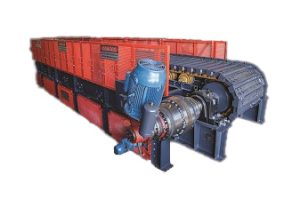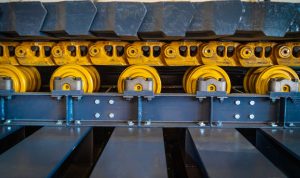BROCHURE
Contact YPT for a detailed information about YPT Apron Feeders.
YPT Quality Management System
For detailed information about YPT Quality Management System
YPT Process Equipment Factory
For detailed information about YPT Process Equipment Factory
APF Series Apron Feeders
Designed for Demanding Material Handling Applications
An apron feeder is a robust machine that moves bulk material from a stockpile, bin, or hopper to other equipment at a regulated rate.
Unlike lighter feeders or belt conveyors, apron feeders are designed to manage large lumps, withstand significant impact, handle wet or sticky materials, and ensure a steady feed rate into crushers or conveyors.
These usually feature overlapping steel pans attached to a sturdy chain or track, moving materials along a trough or frame.
Unlike lighter feeders or belt conveyors, apron feeders are designed to manage large lumps, withstand significant impact, handle wet or sticky materials, and ensure a steady feed rate into crushers or conveyors.
These usually feature overlapping steel pans attached to a sturdy chain or track, moving materials along a trough or frame.
Heavy-Duty Feeding for the Toughest Conditions
Special Parts
4
1
2
3
5
6
1 | Pans (plates) | Overlapping steel pans carry the load and protect chains from direct impact. | 4 | Trough & liners | Heavy frame with replaceable wear liners and impact bars in the loading zone. |
2 | Chains & rollers | Tractor-type chains with carry/return rollers for low friction and long life. | 5 | Sealing & dribble control | Skirt boards and dribble conveyors manage fines and spillage. |
3 | Sprockets & drives | Head sprockets driven by motor/gear reducer; tail sprockets with take-up. | 6 | Controls | VFD for speed control, torque monitoring and interlocks with downstream equipment. |
Production Range
YPT offers the APF Series apron feeders in a comprehensive range of sizes for heavy duty applications.
The following table summarizes the equipment sizes available across YPT standard production range.
The following table summarizes the equipment sizes available across YPT standard production range.
L
W
L
W
| Chain Pitch | Width (mm) |
|---|---|
| D3-135 | 1000 |
| D3-135 | 1200 |
| D4-171 | 1200 |
| D4-171 | 1500 |
| D4-171 | 1600 |
| D4-171 | 1800 |
| D7-216 | 1800 |
| D7-216 | 2100 |
| D7-216 | 2400 |
The feeder length can be tailored to meet the specific demands of the process.
Reliable Under Pressure. Built for Production
Design Criteria
Material characteristics: | Lump size, bulk density, abrasiveness and stickiness govern pan thickness, chain size and liner selection. |
Required feed rate (t/h): | Determines pan width, chain speed and hopper opening geometry. |
Impact & shock loading: | Direct truck or shovel dump requires reinforced pans, impact rails and heavy frames. |
Inclination: | Usually horizontal; limited incline is possible with appropriate pan design and power margin. |
Wear strategy | Replaceable wear liners, sealed chains and adequate lubrication extend service life. |
Drive & tensioning: | Sized for peak torque with reliable take-up/tension systems and guarded sprockets. |
Technical Specifications
Pan / Chain | ~600 – 1,500 mm+ | Selected by capacity and lump size |
Chain | ~0.05 – 0.40 m/s | Low speed limits wear and fines |
Capacity: | ~100 – 5,000 t/h | Function of width, speed and bed depth |
Max Lump | Up to ~1,200 mm | High impact duty with reinforced pans |
Incline: | Horizontal to ~25° | Feasible with correct design and power |
Drive | ~15 – 300 kW | Depends on load, friction and speed |
Operating | −30 °C – +60 °C | Material and lubrication dependent |







